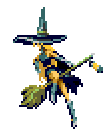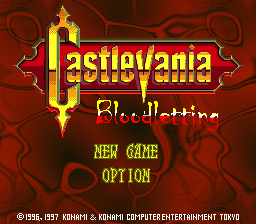
![]() Canceled Games
Canceled Games ![]()
|
Select Your Game
|
[Castlevania: Resurrection] [Castlevania: The Bloodletting] [Symphony of the Night - Game.com]
![]()
|
|
|
|
||||||||||||||||||||
The Lowdown
When the complete history of video games is written, one day, the early 90's will be remembered as a time when the 16-bit console wars were waged and rapidly came to a boil. While NEC's PC Engine (whose later adaptation was known in the west as the Turbo-Grafx 16) had already been running wild in Japan even as far back as 1987, the industry was preparing for a host of new challengers in the form of the Sega Genesis, the Super Nintendo Entertainment System (SNES), the SNK Neo-Geo, and a couple of other bit players. What the history lesson is likely to ignore, either out of overt obliviousness or an obtuse separation (read: the failure to see the true connection), is that the 16-bit wars represented something more--a most peculiar bridge to the next generation of hardware.
What makes the 16-bit generation the most unique period in console evolution is that its participants didn't remain inert in preparation for the industry's eventual leap into the shores of 32-bit, which was still, by all accounts, well off technologically; rather, some companies were intent on exploring the bounds of its potential by bandwaggoning onto a trend started by the PC Engine. NEC, that is, was the first company to expand upon its success with 16-bit consoles by introducing an alternate version of its PC Engine that utilized CD-ROM technology. The add-on and its use of optical media afforded the system's developers more storage space, a significantly increased amount of RAM, and, most importantly to some, the ability to create CD-quality soundtracks and FMV movies for their now-broader-scope games. Eventually, by 1992, NEC combined these technologies together into one package, creating what we know as the Duo or Turbo-Duo.
 |
|
The 32X was a Sega
Genesis add-on - click for larger image
|
SNK responded with the Neo-Geo CD and later the Neo-Geo CDZ while Sega introduced the Sega 32X as an add-on for its Genesis console. Surely, each company thought, a CD-enhanced console was the key to leapfrogging over its competitors to take the 16-bit crown. The only company that didn't share this philosophy, which is not surprising in retrospect, was Nintendo; Sega, which was its chief adversary, wanted especially to capitalize on Nintendo's anti-CD stance, more so when it became clear that the war had now boiled down to the SNES versus the Genesis.
Many problems, however, arose for all those who conformed. For one, people weren't really ready for a pseudo-32-bit era because (a) the use of add-on technology was too confusing in nature and (b) the price tags for CD-enhanced consoles and their games were just absurd. The Neo-Geo, alone, retailed for sometimes upwards of $300 while the Sega 32X was priced at around $170 (not even considering that it was dependent on the Genesis, which itself still retailed at over $100). And even though an inspiring concept that brought forth a lot of promise--which entails the capacity for perfect arcade ports, longer games, sweeping soundtracks, and potential for interactive storytelling using FMV video--high-quality titles were few and far between, game libraries hardly enhanced by their presence; developers never truly realized the systems' potential.
More troublesome for Sega was that its parent company in Japan was already at work creating the Saturn, a true CD-based 32-bit machine. People began to precipitate the misconception that Sega was in conflict with its own interests by having two similar systems on the market when the company instead meant for the 32X to be more a natural, if not opaque, progression toward the next generation. Accepted history suggests the former theory is correct, and it's one of those things of which the now-Sammy-owned Sega will never hear the end.
All of the CD-enhanced 16-bit consoles met the same fate, and, to this day, only Nintendo remains as a true console supplier. What's strange is that (at least the first time around) Nintendo made the correct decision in rejecting CD-based technology, whose pricing was anti-consumer; it's a much different tale, however, when we examine the reemergence of CD-based consoles in light of the 32-bit era, when the machines were built from the ground up for the purpose of maintaining lower development costs and thus pleasing consumers with more product.
So in the end, even in failure, the era of CD-enhanced 16-bit consoles served its purpose in introducing the idea of optical media as the sole means for storing console-game media. Surely Sony, Microsoft and even later Nintendo were paying close attention and now owe the PC Engine, with its conventions, a debt of gratitude for daring to be different in an environment where the consumer persistently demands change and then turns on you when you do.
The Game Explained
The Sega 32X (known in the U.S. as the Sega Genesis 32X , in Japan as the Sega Super 32X, and in Europe and other PAL countries as the Sega Mega 32X), in theory, contributed very little to the world of Castlevania. If you're reading this, I'd bet, you've probably never even heard of a Castlevania: The Bloodletting or know of its tale. But the 32X is significant in this respect, because Bloodletting's never having appeared in its library of games is perhaps one of the best things to ever happen to the series as a whole. To put it simply: By appearing on the system, it would have gone down in flames with the 32X and would have thus become another in a long line of lost titles. This is something Konami couldn't possibly afford after the series' virtual disappearance between the time of Super Castlevania IV and Bloodlines, when the comany was burying its legacy by creating entries for every obscure and short-lived platform on the market. Instead, Bloodletting's significance is purely derived from what it eventually became. But more on that in a moment.
The preamble: As we know, the PC Engine, both pre- and post-CD-enhancement, was extremely popular in Japan and gave Nintendo and its consoles a real run for their money during the period of 1987 to 1994. And as we can say with even more certainty, Konami was of course all over it. IKonami in 1993 released for the CD-based PC Engine one of the series' strongest pillars in the form of Dracula X: Chi no Rondo. Konami used the system's powerful hardware to create a game known for its whimsical graphics, a high-energy presentation, traditional side-crolling action afforded new life thanks to terrific level design, and one of the most stirring soundtracks ever created. Unfortunately, because of the demise of the Turbo-Duo in the mid-90's, the game never knew U.S. or PAL counterparts. Still, Konami knew it had a winner on its hands and was intent on sharing the game's world of ideas regardless of confusing legal issues that prevented the company from porting Rondo over to other 16-bit consoles.
News arrived to publications that a unique Castlevania title was coming to Sega's Genesis via its 32X add-on. Early screenshots revealed a game that very much looked to be in the vein of Rondo of Blood--that is, the classic stage-by-stage formula enhanced by that same sense of open-ended adventure and exploration. But it wasn't meant to be: For developers and publishers, creating and marketing new titles for the 32X was fast becoming a risky proposition what with the Saturn and the Sony PlayStation on the way. Among the concerned publishers was Konami. Considering the lack of details available, it wouldn't be entirely fair to call the game "canceled." Rather, its resources were instead collected and parlayed into another project whose final product would in 1997 appear on the Sony PlayStation. You know it as Castlevania: Symphony of the Night.
In reality, there isn't a whole lot we were told about Castlevania: The Bloodletting or what it was entirely destined to be. Contributor JPCVFAN, however, believes that the sprites below were released by Konami as proof of the game's existence, and they match those found in early Bloodletting screenshots. This is what he found:
 |
|
|
The Heroes
|
The Antagonist
|
Thanks to JPCVFAN, we get direct word from Koji Igarashi that the heroes were meant to be Richter Belmont and Maria Renard, while the antagonist was positioned as a "rival" or, more likely, an instigator whose characteristics are based on a superficial view of foreign culture. Obviously, the "rival" is akin to Charlie Vincent from Castlevania 64 or more likely Belloq from Raiders of the Lost Ark--an aggressive antihero who's looking to trump Richter by being the first to destroy Dracula and to do it by any means necessary.
 |
Richter and Maria's different look is indicative of the series' ever-changing artistic style. After Richter donned appropriate-looking gear in Rondo, he would years later adapt to a more modern look. Apparently, it seems, sleeveless vests and T-shirts were becoming all the rage. Maria would undergo a similar makeover and attitude change and in the process discover hair dye. |
 |
There was no reason to throw away all of this work in converting Bloodletting and its gameplay into Symphony of the Night, and we can see that Konami kept its hero/antihero sprites in mind when creating some of Symphony's characters. For instance:
|
|
~
|
|
|
The rival's sprite-sheet
easily becomes Richter's template
|
||
While you could say that the rival is actually a manipulated Rondo Richter sprite, his template would still be unique in that he was to command moves such as the slide, the super jump and the air dash, which Rondo's Richter lacked. In essence, it was the Symphony version of Richter that became what the rival from Bloodletting was supposed to be. How about instance number two:
|
|
~
|
|
|
Voila - the Richter
sprite becomes Fake Trevor
|
||
You might as well use the Richter sprite for something, right? Well, why not come up with the idea of Shaft employing psychological tactics against the disturbed Alucard by using his memories against him, perhaps by having him fight his former ally? Then, without altering the dimensions, you turn the Richter sprite into a zombie Trevor and no one's the wiser.
Sadly, we don't know what became of Maria's sprite; it could have become anything from a Venus Weed to a Salome to--gasp!--even Alucard.
 |
 |
 |
|
Is that you, Maria?
|
||

All Bloodletting sprites and ideas for converted characters were contributed by JPCVFAN. Thanks also to Sam Mills for providing some source material.
|
[Home] [What's New?] [CV Library] [Stages] [Reviews] [Weapons] [Castleography] [Multimedia] [Codes] [Links] |
||||
